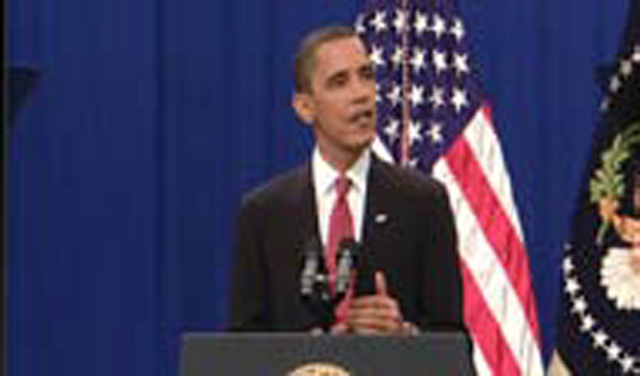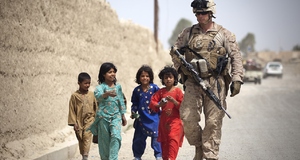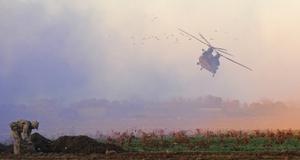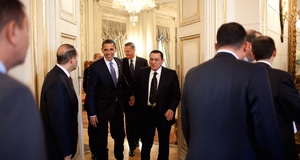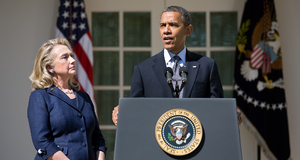From Cornell International Affairs Review VOL. 4 NO. 1Obama and Afghanistan
KEYWORDS
James Goldgeier is professor of political science and international affairs at George Washington University and a 2010-2011 senior fellow at the Transatlantic Academy in Washington, D.C. He taught at Cornell from January 1991 to December 1993. His most recent book (co-authored with Derek Chollet) is America Between the Wars: From 11/9 to 9/11 (Public Affairs 2008), named “a best book of 2008” by Slate and “a favorite book of 2008” by The Daily Beast. In his campaign for the American presidency, Barack Obama emphasized the “right war” in Afghanistan in order both to highlight the folly of the “wrong war” in Iraq and to establish that he was not against all wars – just “dumb” ones.1 Al Qaeda’s safe haven in Afghanistan prior to September 11, 2001 produced the plans and personnel that led to the terrorist attacks on New York and Washington, D.C. Unfortunately, argued Obama, the George W. Bush administration distracted itself from the job of eliminating al Qaeda by bungling its way into Iraq. Emboldened, the Taliban began to undermine the U.S.-backed Afghan government and sought to return to power, raising the specter of a renewed training ground for Islamic extremists. As president, Obama promised the American voters, he would devote the resources necessary to successfully prosecute the counterinsurgency campaign. In his first months in office, Obama moved swiftly to fulfill his campaign pledges. He appointed the Democratic Party’s star troubleshooter, Richard Holbrooke, as his special representative for Afghanistan and Pakistan. He ordered a strategy review to be completed in his first months in office. Even before the review was finished, Obama had announced a substantial increase in American troops for the conflict, amidst reports that the number would grow even further as the year wore on. And in the summer he inserted as commander of the U.S. forces in Afghanistan General Stanley McChrystal, whose Special Forces background would ensure a keen understanding of what was required to wage a successful counterinsurgency campaign. Obama’s determination to prosecute the war, however, ran into two serious problems during the summer of 2009. One was the failure of Afghan President Hamid Karzai to inspire confidence in the legitimacy of his government; the August elections involved massive voter fraud, making it more difficult to gain public support, either in Afghanistan or the United States, for the American military effort. The other was the skittishness of the Democratic Party; with an economy continuing to sour, leading members of Congress, such as House Speaker Nancy Pelosi (D-CA), made clear their desire to draw down the military effort, particularly as the number of American battle deaths continued to rise. With the announcement that 30,000 additional American troops would head to Afghanistan in 2010 to reverse the momentum of the Taliban balanced against the declaration that those troops would begin coming home the following year, Obama’s December 2009 West Point speech highlighted that the president had no good options in Afghanistan. He does not know whether American and allied forces can train Afghans in sufficient quality and quantity to take over responsibility for protecting the government, but he does not want an indefinite American presence. While Obama’s early rhetoric about the stakes involved in the conflict suggested that the United States needed to make an all-out effort, the December 2009 speech highlighted that the president was eager to emphasize that he could find a way out. The news at West Point was the exit date. The White House had leaked for weeks that the president was likely to order 30,000 more troops into battle. By beginning to talk about when he would start getting out, the president reflected the larger mood of the country. At the end of eight years and in the face of continued high unemployment, Americans were tired of hearing that they needed to be at war. At West Point, Obama began to change to narrative from his earlier commitment to a “war of necessity” to a story that would make clear that his election in 2008 meant that America would not be at war indefinitely. By reminding voters that all combat troops would leave Iraq by the end of 2011 and telling them that troops would begin to leave Afghanistan, Obama signaled that his reelection campaign in 2012 would trumpet his efforts to end America’s wars, not intensify them. A War of Necessity?The distinctions Obama drew between Iraq and Afghanistan during the campaign in 2008 were vital to his candidacy, but they also contributed to the growing sense in 2009 that the Afghanistan war had now become “Obama’s war.” In the campaign, he scored points with the Democratic Party base by emphasizing his opposition to the Iraq war from the start (in contrast to his chief opponent for the nomination, New York Senator Hillary Clinton); he built his credentials with independents by arguing the need to transfer troops, resources, and attention away from Iraq to the war in Afghanistan. “Iraq is not the central front in the war on terrorism, and it never has been,” wrote candidate Obama in a New York Times op-ed in July 2008. “As president, I would pursue a new strategy, and begin by providing at least two additional combat brigades to support our effort in Afghanistan. We need more troops, more helicopters, better intelligencegathering and more nonmilitary assistance to accomplish the mission there.”2 A week after the president took office, administration officials sent signals that the president sought to focus more American attention on the war, leaving development work to be done by European allies, and they made clear to Afghan President Hamid Karzai that they had no intention of tolerating his corruption. Narrowing the American emphasis, U.S. Secretary of Defense Robert Gates declared, “If we set ourselves the objective of creating some sort of Central Asian Valhalla over there, we will lose.” Therefore, he added, “My own personal view is that our primary goal is to prevent Afghanistan from being used as a base for terrorists and extremists to attack the United States and our allies.”3 Two months later, the administration released its strategy review for Afghanistan and Pakistan, and the president made clear that he was focused on one major objective. “I want the American people to understand,” said Obama, “that we have a clear and focused goal: to disrupt, dismantle and defeat Al Qaeda in Pakistan and Afghanistan, and to prevent their return to either country in the future.” Following his campaign rhetoric about the central front in the war on terror, the president declared, “Al Qaeda and its allies – the terrorists who planned and supported the 9/11 attacks – are in Pakistan and Afghanistan. Multiple intelligence estimates have warned that Al Qaeda is actively planning attacks on the United States homeland from its safe haven in Pakistan.” Combating the threat, Obama said, was not simply a matter of finding Al Qaeda members and eliminating them. It also meant going after the Taliban, a task for which he had ordered 17,000 additional American combat troops: “[I]f the Afghan government falls to the Taliban – or allows Al Qaeda to go unchallenged – that country will again be a base for terrorists who want to kill as many of our people as they possibly can.”4 President Obama addresses the outlook for American involvement in Afghanistan suring his December 2009 speech at West Point. The strategy paper recognized, however, that the counterinsurgency campaign would not be successful without focusing some attention on government capacity, economic development and indigenous security capabilities in both Pakistan and Afghanistan – i.e., nation building. In his March address, the president announced his support for a bill in Congress that would provide $1.5 billion yearly in assistance to go directly to the Pakistani people for 5 years. A further goal was to train Afghan army and police forces to create by the end of 2011 a 134,000 strong Afghan army and an 82,000 member police force (a number that many, including Holbrooke and McChrystal, deemed inadequate). One major innovation of the new administration’s approach was linking the fate of the two nations, thereby giving rise to the term “AfPak.” As the White Paper put it, “The ability of extremists in Pakistan to undermine Afghanistan is proven, while insurgency in Afghanistan feeds instability in Pakistan.” It also laid out what it called “realistic and achievable objectives.” These included, however, “promoting a more capable, accountable, and effective government in Afghanistan,” and “assisting efforts to enhance civilian control and stable constitutional government in Pakistan and a vibrant economy that provides opportunity for the people of Pakistan.” The White Paper itself noted, “These are daunting tasks.”5 A second new strategy element would be the effort to distinguish between those Taliban deemed “irreconcilable” and those viewed as willing to end their insurgency. The paper explicitly sought to get “nonideologically committed insurgents to lay down their arms, reject Al Qaeda, and accept the Afghan Constitution.” This element of the strategy reflected the perceived success in Iraq resulting from turning former insurgents into responsible participants of the developing new order. At the end of the summer, Obama reiterated his thinking on the war in an address before the Veterans of Foreign Wars Convention in Phoenix: “[M]ilitary power alone will not win this war …[W]e also need diplomacy and development and good governance. And our new strategy has a clear mission and defined goals: to disrupt, dismantle, and defeat al Qaeda and its extremist allies.” He added, “This is not a war of choice. This is a war of necessity.”6 Having said it was not a choice, he suggested that he was prepared to see it through to the end. Ironically, the person chiefly responsible for bringing the terms “wars of choice” and “wars of necessity” into the American debate, Richard Haass, president of the Council on Foreign Relations and author of a book comparing the two Iraq wars, suggested the president had it wrong. Surely, said Haass, the United States had to go after the Taliban initially to get at the source of the 9/11 attacks. But a war of necessity involved both “vital national interests” and a “lack of viable alternatives to the use of military force to protect those interests.” Under those criteria, Afghanistan didn’t count. If it were a war of necessity, Haass wrote, “it would justify any level of effort. It is not and does not.” 7 By laying down such a clear marker on the necessity of fighting the war, the president made it extremely difficult to do anything other than ramp up the American commitment. But the administration sent mixed signals as 2009 wore on. Obama did announce a troop increase after coming into office before his strategy review was even complete. But his National Security Adviser James Jones caused a stir that summer when on a visit to Afghanistan, he made clear that asking for more troops so soon after Obama had ordered 21,000 troops to deploy (17,000 in a combat role, 4,000 to train Afghan forces) would cause the president to have a “Whiskey Tango Foxtrot” (What the f---?) moment.8 According to sources close to the team advising McChrystal, as the new commander was preparing his policy review for the president, Secretary Gates also made clear that asking for more troops was unwise.9 One major innovation of the new administration’s approach was linking the fate of the two nations, thereby giving rise to the term “AfPak.” As summer gave way to fall in Obama’s first year, the president was putting himself in an unenviable position, having declared that the war was one the United States had to win but not wanting to escalate the number of American troops any further. He had promised that Bush’s “underresourced war” would now finally get the attention it deserved. But would it? A New Commander and a New StrategyAs the Obama team prepared to assess its policy for the second time that year, General McChrystal’s review of the situation and his recommendations going forward to fulfill the president’s goals became the central focus of both supporters and critics of the war. McChrystal had established two new objectives for a more successful counterinsurgency strategy after replacing Gen. David McKiernan as theater commander. One was to protect the population of Afghanistan; the new commander was concerned that ISAF spent too much time on troop protection and not enough on providing security for the population. The second was to reduce civilian casualties, whose rise had turned the Afghan population against the Western military effort (as well as cost support for the mission in Europe). McChrystal declared, “The point of security is to enable governance…. My metric is not the enemy killed, not ground taken: it’s how much governance we’ve got.”10 A list of the metrics that would be used to gauge success appeared online in mid-September.11 It reiterated the basic goal laid out by the president in March: “to disrupt, dismantle, and defeat Al Qaeda in Pakistan and Afghanistan, and to prevent their return to either country in the future.” But the document demonstrated the difficulty of merely disrupting terrorist networks rather than more ambitious governance goals. There were metrics clearly focused on measuring the strength of the insurgency – e.g., how much territory the insurgents held vs. that secured by American, coalition and Afghan government forces. But a number of the metrics had to do with the effectiveness and popularity of the government in Afghanistan and Pakistan. Whereas goals such as increasing Pakistani counterinsurgency capabilities or strengthening Afghan national security forces are within reason, however, laying out metrics that include Pakistani public opinion of government performance and progress in that judicial system becoming free of military involvement would simply set the Obama administration up for never-ending nation building.12 McChrystal’s initial assessment of the situation in Afghanistan was delivered to Washington on August 30, leaked to Bob Woodward of the Washington Post and published on September 21, creating a firestorm in the nation’s capital. McChrystal suggested in his report that readers not focus on force or resource requirements; “The key takeaway from this assessment,” he wrote, “is the urgent need for a significant change to our strategy and the way that we think and operate.” He reiterated that the mission had to shift its emphasis from “seizing terrain or destroying insurgent forces” and focus on the Afghan population (a strategy that had led to increasing numbers of American casualties). He argued that the next year was critical for laying the ground for success; failure to gain the initiative would risk “an outcome where defeating the insurgency is no longer possible.” Building up indigenous capabilities was essential, and McChrystal called for increasing the size of the Afghan army to 134,000 not by December 2011 as originally called for but by October 2010, with an eye toward then going up to 240,000.13 The leaking of the assessment highlighted differences within the administration and on Capitol Hill. Vice President Biden, who opposed the troop increases announced at the onset of the administration, was once again arguing against more troops and reconfiguring the strategy to focus on knocking out individual Taliban and Al Qaeda leaders from afar. Hillary Clinton, meanwhile, who supported the troop increase in the spring, continued to do so in the fall as did Secretary of Defense Robert Gates, who supported his military commanders. While Obama’s Democratic base made clear its opposition to more troops, Republicans such as John McCain urged Obama to stand tough. The White House made clear, however, that it was rethinking a strategy that Obama had outlined in March and reiterated in August. Although it is hard to imagine anyone was surprised that President Hamid Karzai engaged in massive electoral fraud to stay in office, some in the administration were calling his growing illegitimacy a “game-changer.” Combined with Congressional Democratic opposition, an increase in American casualties, and eroding public support, that election led officials in Washington to begin to redefine their strategy.14Continued on Next Page » Suggested Reading from Inquiries Journal
Inquiries Journal provides undergraduate and graduate students around the world a platform for the wide dissemination of academic work over a range of core disciplines. Representing the work of students from hundreds of institutions around the globe, Inquiries Journal's large database of academic articles is completely free. Learn more | Blog | Submit Latest in International Affairs |


